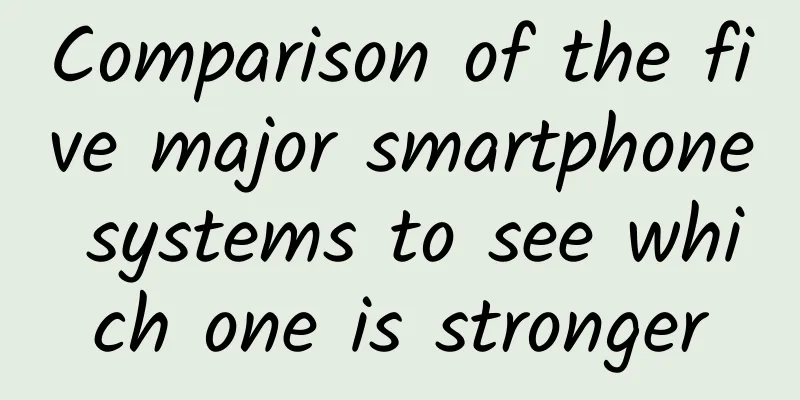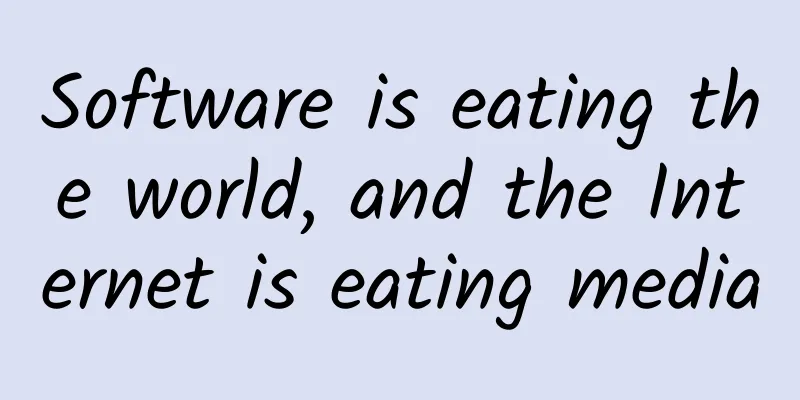Comparison of the five major smartphone systems to see which one is stronger

|
Smartphones are mobile phones with more powerful computing power and functions than traditional feature phones. The most commonly used operating systems are Symbian, Windows Phone 7, iOS, Android and BlackBerry OS. So which mobile phone system is better? Below, the editor has compiled a comparison of smartphone systems for everyone, welcome to read for reference. Yesterday's King - Symbian Symbian, the former king of smart phones, was once popular from 2005 to 2010. Many people on the street were holding Nokia Symbian phones, such as N70, N73, N78 and N97. Nokia's N series was once known as the "N = Biggest" phone. Low hardware level, simple operation, power saving and rich software resources are the important features of Symbian system phones. In the domestic software development market, almost every software has a corresponding Symbian mobile phone version. The initial goal of Symbian development was to ensure long-term stable and reliable operation on devices with lower resources, which resulted in a steeper learning curve for Symbian application development and higher development costs. However, the program's operating efficiency is very high. For example, with 128M RAM of 5800, more than 10 programs can be run at the same time in the background and the operation is smooth (the multi-tasking function is particularly powerful), and its remaining memory remains stable even if it is not turned off for several days. Although Nokia was under siege by Android and iOS, it launched the Symbian^3 system and even continued to update it (Symbian Anna, Symbian Belle). There were significant improvements from the external user interface to the internal functional features, such as new customizable window components, more home screens, new drop-down menus, etc. Due to its poor support for emerging social networks and web 2.0 content, Symbian's market share in the smartphone market has been shrinking. At the end of 2010, its market share had been surpassed by Android. Since the end of 2009, major manufacturers including Motorola, Samsung Electronics, LG, Sony Ericsson, etc. have announced the termination of the development of the Symbian platform and turned to the Android field. In early 2011, Nokia announced that it would form a strategic alliance with Microsoft to launch a smartphone based on Windows Phone, thus actually abandoning Symbian, which had been operating for many years, and the delisting of Symbian was a foregone conclusion. Current Trend - Android The word Android first appeared in the science fiction novel "L'ève future" published by French writer Auguste Villiers de l'Isle-Adam in 1886. He named the machine that looks like a human Android. Since HTC and Google jointly launched the first Android phone, G1, in 2008, Android's global market share surpassed Symbian for the first time in the first quarter of 2011, becoming the world's largest. According to data from November 2011, Android occupied 52.5% of the global smartphone operating system market, and the market share in China was 58%. Today, Android has become the mainstream smartphone operating system on the market, and you can see this green robot everywhere. Why has Android become so popular in such a short time? 1. Open source. This is the most critical factor for Android's rapid growth. Before Android, no other smart operating system was as open source as Android. Android's open source breaks the licensing model of previous operating system platforms, which not only reduces manufacturers' costs but also gives them more room for freedom and increases their enthusiasm for supporting Android. This is the source of the Android platform's rapid maturity and growth. 2. Alliance. Alliance strategy is another magic weapon that Android can use to conquer cities and capture strongholds. Symbian also used the alliance strategy before, but due to the lack of open source, the system became bloated and unsustainable, and partners left the camp one after another. In terms of alliance members, the Symbian Alliance is mainly composed of mobile phone manufacturers. The Open Handset Alliance (OHA) established by Google for Android is not only supported by many big-name mobile phone manufacturers such as Motorola, Samsung, HTC, and Sony Ericsson, but also supported by mobile phone chip manufacturers and mobile operators, with 34 founding members alone. Open source and alliance, Android has gathered strength from almost all over the world. This is the fundamental reason why the Android image and voice can be spread to every corner of the global mobile Internet market. 3. Technology. The underlying operating system of the Android system is Linux. As a free, easy-to-obtain operating system with freely modifiable source code, Linux has absorbed the essence of countless programmers around the world. This is the biggest reason why the Android system is more extensible than Symbian. In addition, as an embedded operating system, Linux makes it easy for Android to be applied and ported to various platforms and develop rapidly. At the same time, the faster version update speed of the Android platform makes the hardware performance of mobile phones continue to develop in the most advanced direction, and also makes the features of Android playable, fun and easy to play more and more obvious. There are a large number of Android models, which are easy to use and have a fairly free system that allows manufacturers and customers to easily customize various ROMs, desktop widgets and themes. The simple and gorgeous interface is recognized by the majority of customers, and flashing the phone is also something that many Android users enjoy talking about. Unfortunately, there are many Android versions. There are various versions of Android phones on the market, such as 1.6, 2.0, 2.1, 2.2, and 2.3. The compatibility of application software with various versions of the system is a challenge for program developers. At the same time, due to the low development threshold, although there are many applications, the quality of applications varies, and even many malicious software has appeared, causing losses to some users. At the same time, Android does not restrict the hardware of various manufacturers, resulting in poor experience for some users on low-end models. On the other hand, because Android applications are mainly developed in Java language, its operating efficiency and hardware consumption have always been criticized by other mobile phone users. Noble and gorgeous——iOS iOS, as the operating system for Apple's mobile devices iPhone and iPad, has become one of the most popular operating systems in the world under the promotion of the App Store. Originally, this system was called "iPhone OS" until it was renamed "iOS" at the WWDC conference on June 7, 2010. The concept of iOS's user interface is based on the ability to use multi-touch direct operation. Control methods include sliding, tapping switches and buttons. Interaction with the system includes sliding (Swiping), tapping (Tapping), pinching (Pinching, usually used to zoom out) and reverse pinching (Reverse Pinching or unpinching, usually used to zoom in). In addition, through its built-in accelerator, it can be rotated to change its y axis to change the direction of the screen. This design makes the iPhone easier to use. The earliest iPhone OS 1.0: built into the first generation of iPhone, with the help of the iPhone's smooth touch screen, iPhone OS brought users an extremely excellent user experience, which can be described as amazing compared to mobile phones at that time. iPhone OS 2.0: With the release of iPhone 3G, App Store was born. App Store provides a convenient and efficient software sales platform for third-party software providers, building a bridge of communication and sales between software developers and end users, thus greatly enriching the functional applications of iPhone. iPhone OS 3.0: iPhone 3GS began to support copy and paste. The official beginning of iOS: iOS 4. When iPhone 4 was launched, Apple decided to rename the original iPhone OS system to "iOS" and released a new generation of operating system: "iOS 4". In this version, multitasking was officially supported, which was achieved by double-clicking the HOME button. iOS5: Siri voice assistant function is added, users can realize language human-computer interaction with the phone. This function can realize voice recognition of users and complete some more complex operations. Use Siri to check the weather, navigate, ask the time, set alarms, check stocks and even send text messages, which is convenient for users. From the initial iPhone OS to the latest iOS system, iOS has become Apple's new mobile device operating system, spanning iPod Touch, iPad, and iPhone, becoming Apple's largest operating system. Even the new generation of Mac OS X Lion has borrowed some designs from the iOS system. It can be said that iOS is another successful operating system of Apple, which can bring users a great experience. With excellent system design and strict App Store, iOS, as the mobile device operating system with the largest number of applications, coupled with powerful hardware support and the latest iOS5 built-in Siri voice assistant, has undoubtedly greatly improved the user experience and let people feel the benefits of technology. However, devices using iOS are generally more expensive than other devices, which makes them less attractive to entry-level users. Moreover, Siri can only be used on iPhone 4s for the time being and does not support Chinese, making it a useless feature in China. A new look - Windows Phone As early as 2004, Microsoft began to develop an important version update of Windows Mobile under the code name "Photon", but the progress was slow and the entire plan was cancelled. It was not until 2008, under the impact of iOS and Android, that Microsoft reorganized the Windows Mobile team and continued to develop a new mobile operating system. It was originally planned that its official version would be released in 2009, but many delays made Microsoft decide to use Windows Mobile 6.5 as a transition. The development of Windows Phone was completed in one fell swoop. One of the consequences is that old Windows Mobile applications cannot run properly on the Windows Phone system. Terry Myerson, vice president of Windows Phone development, said: "In order to improve the user experience of Windows Phone 7 by not using a stylus, switching to a capacitive touch screen, and other hardware changes, we had to break the application compatibility of Windows Mobile 6.5." Windows Phone, as the successor to Windows Mobile, uses a new user interface called "Metro", which is very similar to Microsoft's discontinued Kin. Its main screen, also known as the "start screen", is composed of many square or rectangular graphics, called "Live Tiles". Live tiles are equivalent to buttons that can be linked to applications, functions, and other independent components (such as contacts, web pages or media items). Users can add, rearrange or delete live tiles. Even when the device is locked, live tiles can be updated at any time according to the content they represent - for example, the live tiles of emails will show how many emails have not been read; or the live tiles of weather can also display real-time updated weather content. Currently, live tiles only support vertical layouts and cannot be displayed in landscape mode. The new Windows phone combines the advantages of the Internet, personal computers and mobile phones, allowing people to enjoy the desired experience anytime and anywhere. The built-in office suite and Outlook make office work more efficient and convenient. In terms of applications, although Windows phone provides good development tools, and Microsoft has imposed strict restrictions on developers to develop applications in order to standardize the user experience of Windows Phone 7, developers must strictly follow these development restrictions and terms to develop applications. For example, developers cannot develop applications involving mobile phone cameras; developers cannot customize the interface of applications privately; applications involving system classes must use the interface provided by the system to run; developers must send developed applications to mobile phones through the Zune synchronization function, but the number of applications for Windows phone is still small. On the one hand, the interface of Windows phone is unique, and there are few places that can be customized, which is easy to cause aesthetic fatigue; on the other hand, although the latest version of Windows Phone 7.5 began to support multitasking, it can only run up to 5 programs, and multitasking seems to be inadequate. Windows Phone started early but developed slowly. However, Windows Phone 7 has been applied to NOKIA phones and has been promoted to the market as the main operating system for NOKIA phones. High-end business——Blackberry OS Blackberry system is an operating system for wireless handheld email solution terminal devices launched by Canadian Research In Motion (RIM), which is independently developed by RIM. It is different from other mobile phone terminals using operating systems such as Symbian, Windows Mobile, and iOS. The encryption performance of Blackberry system is stronger and more secure. A BlackBerry with the BlackBerry system installed is not just a mobile phone, but a Push Mail real-time email service launched by Research in Motion, which includes servers (email settings), software (operating interface) and terminals (mobile phones). The Blackberry mobile email device is based on two-way paging technology. The device is combined with RIM's server, relies on specific server software and terminals, and is compatible with existing wireless data links, making it possible to send and receive emails anywhere and anytime across North America. This device does not attract attention with its fantastic pictures and color screen, and it does not even have a speaker. After the 9/11 incident, the Blackberry terminal craze in the United States was triggered by its timely transmission of information from the disaster site. The most important principle for BlackBerry's success is to provide an integrated solution for mobile office for senior white-collar workers and business people. Enterprises have a lot of information that needs to be processed immediately, and when they are on business trips, they also need a wireless and mobile office device. Enterprises only need to install a mobile gateway and a software system to achieve seamless connection using the mobile phone platform, so that employees can use their mobile phones to work anytime and anywhere. Its most convenient feature is the email push function: the email server actively pushes received emails to the user's handheld device, without the user having to frequently connect to the network to check whether there are new emails. BlackBerry's system stability is excellent, and its unique positioning is also favored by business people. However, it does not have an advantage in the mass market, and there are fewer domestic users and application resources. |
<<: Practice of Android automated page speed measurement in Meituan
>>: How do mobile phones leak information? If you don't know, read this
Recommend
How to do automobile marketing in the new era?
Telemarketing is difficult nowadays because the s...
This tree has a "ghost face", but it is loved by people...
Many people shudder when seeing the word "gh...
Interesting Talk about AI: A Bottle of Wine "Assists" the Wandering of the Earth
1. Let’s start from watching “The Wandering Earth...
Elvis Presley's grandson shot himself, and the police are investigating the reason!
[Elvis Presley's grandson shot himself] Accor...
Today is the Winter Solstice | Should we eat dumplings or glutinous rice balls?
In your hometown Should we eat dumplings or gluti...
There is a new breakthrough in the "bottleneck" technology. What is the use of "hand-torn steel" that can be torn apart easily?
"Flat, thin, smooth, glossy and hard, as thi...
This drug-sniffing dog made the news for attacking a duckling!
In drug control work, there is an animal that has...
You may not know these updates! Android 9.0 has these interesting features
Google has released the latest generation of Andr...
How does WeChat Reading use social networking to increase user growth?
WeChat , with 1 billion users, has long been at t...
The first cold wave of 2024 is about to hit, please check the disease prevention and frost prevention guidelines!
01 Rainfall continues in Jiangnan and other place...
Electric Technology Car News: Can the reborn Changan Lingxuan, with a more textured exterior and interior, gain a foothold in the MPV field?
With the change in domestic family travel methods...
Scientists discovered nine ultra-lithium-rich dwarfs at once based on LAMOST's medium-resolution spectrum
Author | LAMOST Operation and Development Center ...
They love candied haws more than nectar. Are these bees stupid?
Author: Shi Jun Reviewer: Yao Jun (Associate Rese...
Using the names of books to make tens of thousands of dollars a year, this project can be operated by everyone
There are many online earning projects. It is rec...
Manta rays: Even if they are called "devil", they still dance gracefully on the sea
Manta rays are an ancient cartilaginous fish that...









